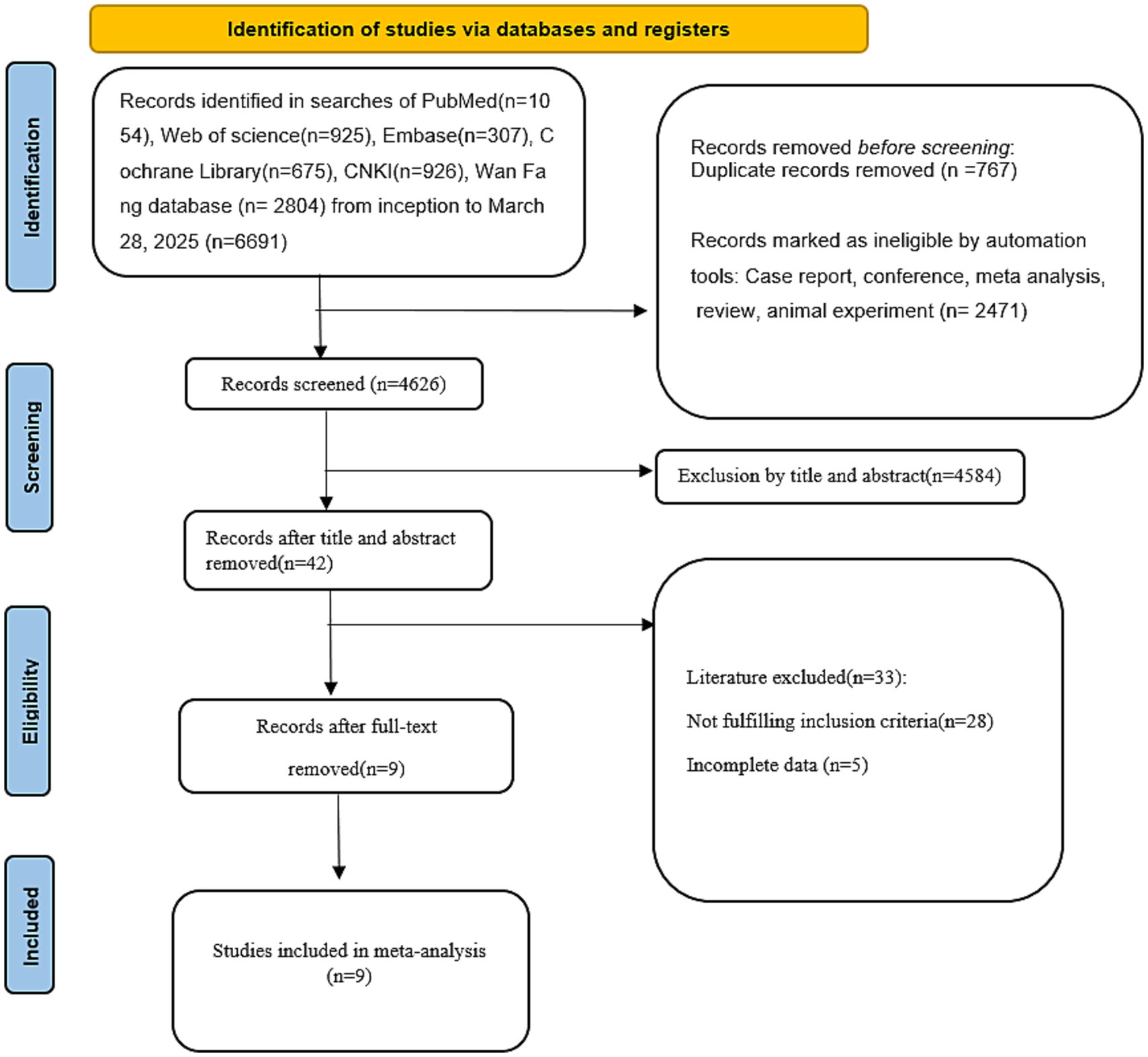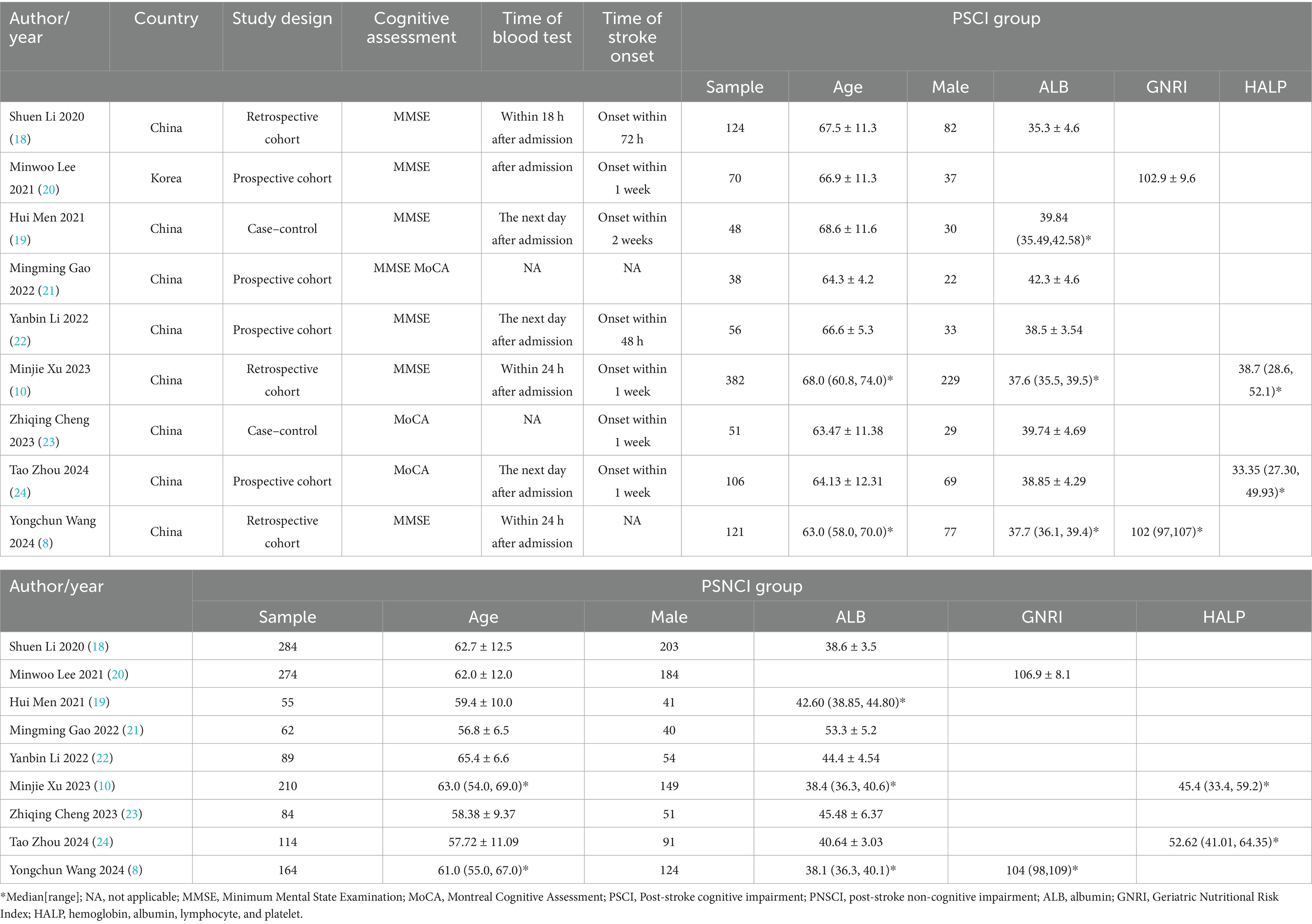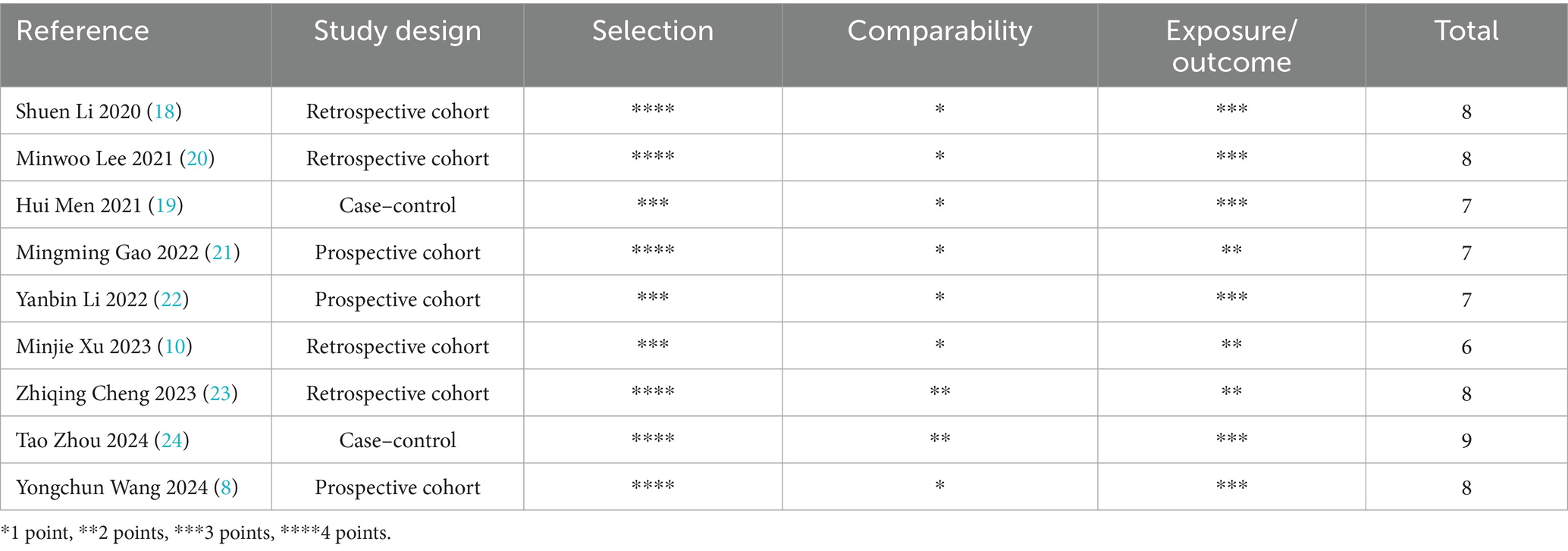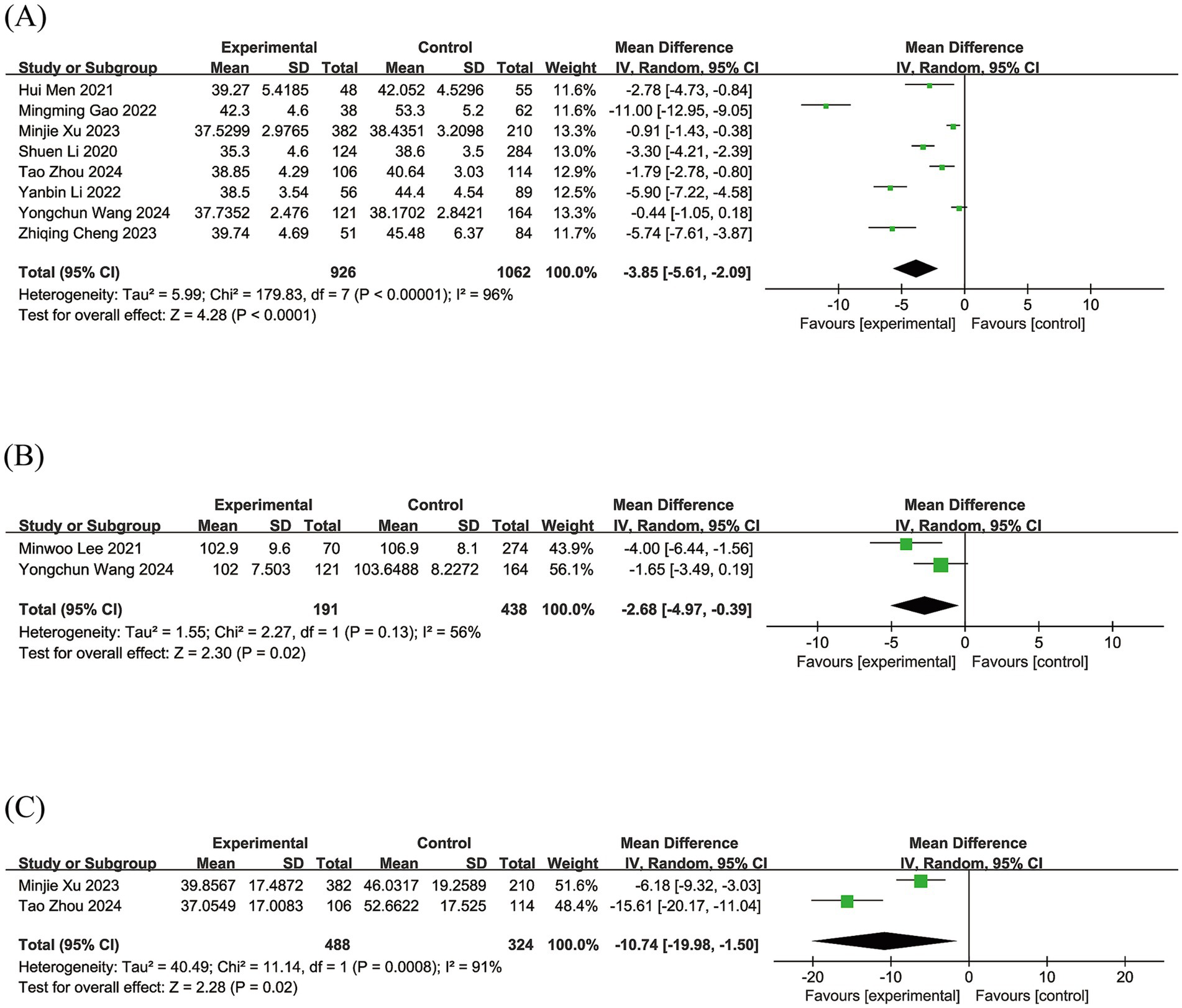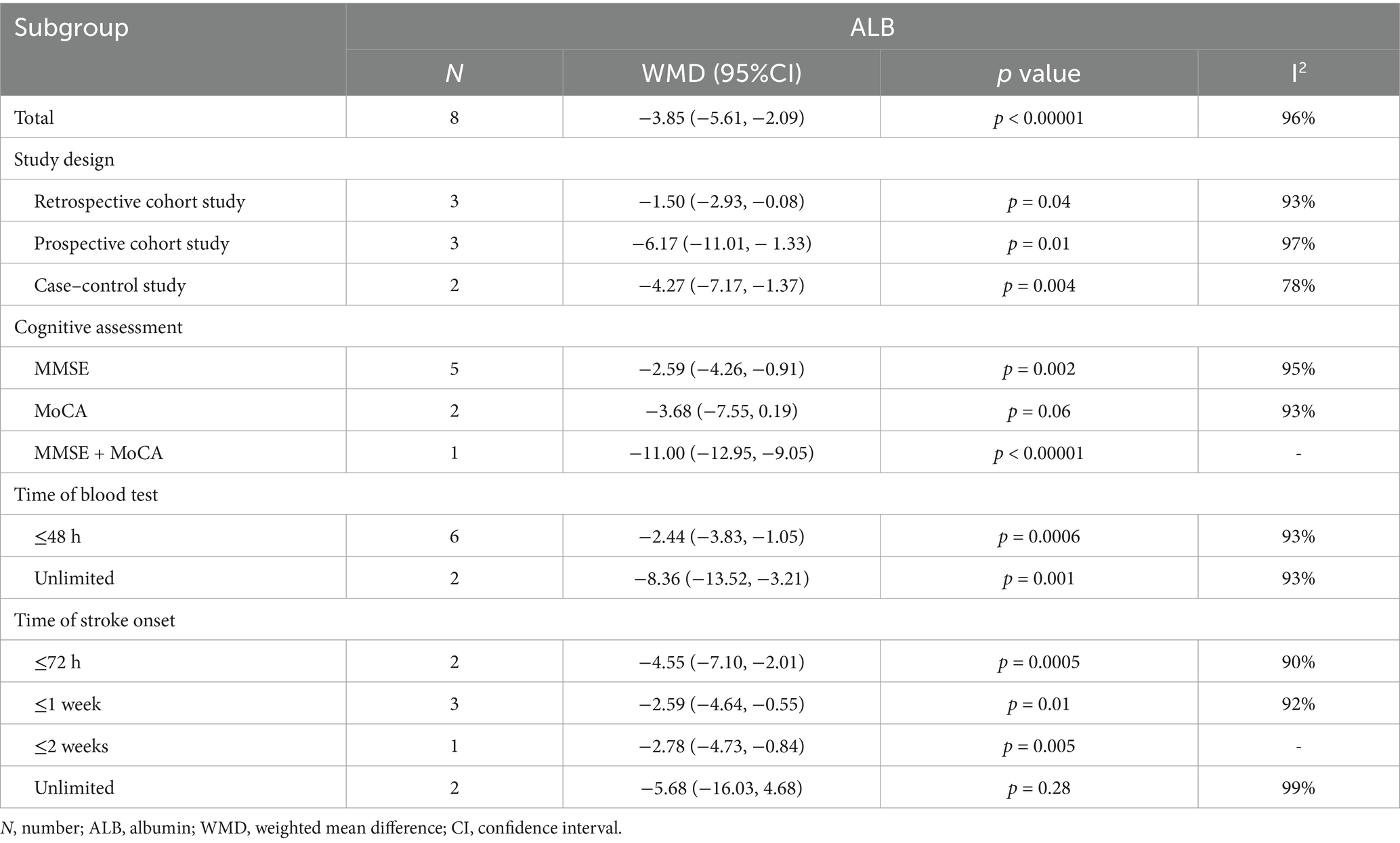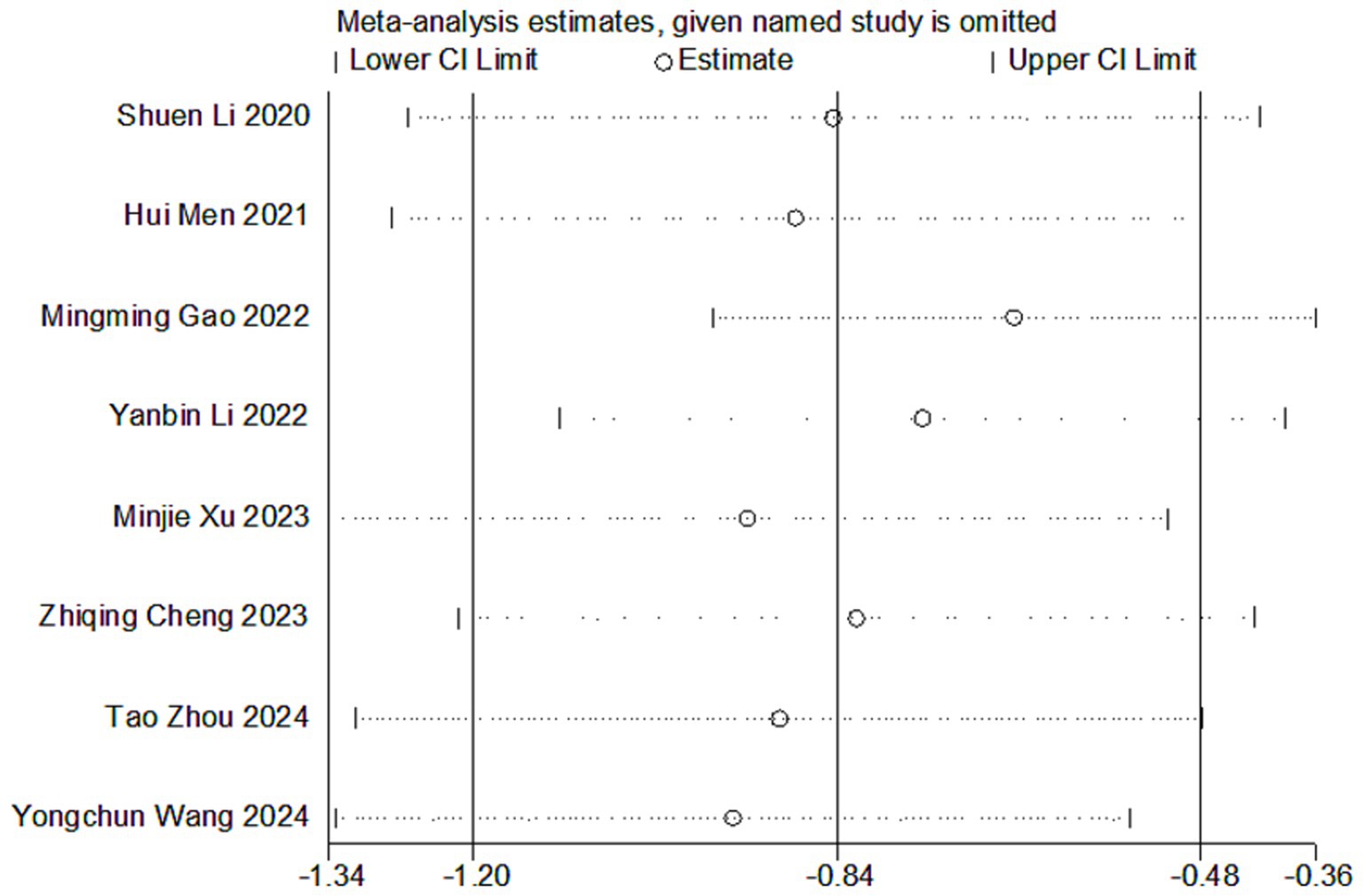- 1School of Health Preservation and Rehabilitation, Chengdu University of Traditional Chinese Medicine, Chengdu, China
- 2Department of Neurology, Affiliated Sichuan Provincial Rehabilitation Hospital of Chengdu University of Traditional Chinese Medicine, Chengdu, China
Background: The role of serum albumin levels and albumin-related nutritional indices in the prediction of cognitive impairment after stroke has not reached a uniform conclusion.
Methods: This study was prospectively registered in PROSPERO (CRD420251012150) and followed the PRISMA guidelines. We systematically searched six databases with a time frame from the date of database establishment to March 29, 2025. Literature selection and data collection were conducted by two researchers. Assessment of literature quality was performed according to the Newcastle-Ottawa Scale (NOS). Weighted mean difference (WMD) with 95% confidence intervals (CIs) was used to express pooled effect sizes. The chi-square (χ2) test (Cochran’s Q) and index of inconsistency (I2) were used to detect heterogeneity.
Results: A total of 9 studies involving 2,332 stroke patients were included in this meta-analysis. The results of this study showed that serum albumin levels (WMD: −3.85; 95% CI: −5.61, −2.09; p < 0.0001), Geriatric nutritional risk index (GNRI) (WMD: −2.68; 95% CI: −4.97, −0.39; p = 0.02), and HALP (hemoglobin, albumin, lymphocyte, and platelet) scores (WMD: −10.74; 95% CI: −19.98, −1.50; p = 0.02)were significantly lower in the post-stroke cognitive impairment (PSCI) compared to the post-stroke non-cognitive impairment (PSNCI).
Conclusion: Decreased serum albumin levels and albumin-related nutritional indices (GNRI and HALP scores) have a strong correlation with PSCI, which may become important indicators for early prediction of the development of PSCI.
Systematic review registration: https://www.crd.york.ac.uk/prospero/#recordDetails, identifier, CRD420251012150.
1 Introduction
Stroke, the most common cause of mortality worldwide, has imposed a huge economic burden on society due to its increasing incidence, high mortality, and disability rates (1). Post-stroke cognitive impairment (PSCI) is a complication of stroke characterized by memory loss, visuospatial deficits, and decreased executive functioning (2, 3). It will lead to irreversible cognitive impairment if not intervened on promptly, which can severely impact a patient’s quality of life and longevity (4). The study suggests that the period between stroke occurrence and the development of PSCI is a critical treatment window for the prevention of cognitive impairment (5). Accordingly, it is essential to identify predictive indicators for effective screening of people at risk for PSCI at early stages so as to improve the quality of patients.
The rates of malnutrition after stroke can be as high as 62% (6). Research has shown a strong association between nutritional condition and cognitive performance, and a favorable state of nutrition is crucial for the maintenance and improvement of cognitive performance (7, 8). Serum albumin is one of the major proteins in the blood with functions in maintaining nutrition and osmolality in the body, and is often used as an important indicator of a patient’s nutritional status (9, 10). Studies indicated that serum albumin can improve cerebral circulation and has a protective effect on both neurons and glial cells (11). Decreased serum albumin levels also indicate poorer functional prognosis after stroke (12, 13). In recent years, albumin-related nutritional indices, such as the Geriatric Nutritional Risk Index (GNRI) and the HALP (hemoglobin, albumin, lymphocyte, and platelet) scores, have been increasingly used in cancer prognosis (14, 15). However, it is unclear whether these indices are relevant to PSCI. Consequently, the purpose of this research was to evaluate the value of serum albumin levels and albumin-related nutritional indices in the prediction of PSCI by providing evidence for their application in the prevention and intervention of cognitive impairment after stroke.
2 Methods
This meta-analysis identified the predictive value of albumin-related nutritional indicators for PSCI. The study protocol was registered in PROSPERO (CRD420251012150) and conducted according to the PRISMA guidelines. The PRISMA 2020 checklist can be found in Supplementary Table S1.
2.1 Search strategy
We searched PubMed, Embase, Cochrane Library, Web of Science, China National Knowledge Infrastructure (CNKI), and Wanfang databases systematically, with a search timeframe from database creation to March 29, 2025. In addition, we manually searched other literature that might meet the inclusion criteria. The search terms are shown in Supplementary Table S2.
2.2 Criterion of inclusion and exclusion
2.2.1 Inclusion criteria
(1) The participants in the study were patients who suffered or did not suffer from any cognitive impairment after stroke; (2) Target predictors included serum albumin levels and albumin-derived composite indices (specifically GNRI and HALP); (3) observational studies.
2.2.2 Exclusion criteria
(1) Reviews, meta-analysis, conference, case report, duplicate literature, dissertations, animal experiments; (2) full text or complete data unavailable; (3) studies not in English or Chinese.
2.3 Literature selection and data extraction
Researchers (YQW, FLQ) independently completed the literature screening and data extraction process. When disagreements occurred, they were discussed with the researcher (XH) until a consensus was reached. When the continuous variable in the study was reported as median, we calculated means±standard deviations (SD) by using methods that have been validated (16, 17). If the data was incomplete, we tried to contact the authors by email to acquire the complete data.
2.4 Quality assessment of literature
Two researchers (YQW, XLH) conducted the quality assessment of the included literature by using the Newcastle-Ottawa Scale (NOS). This scale is scored out of nine points and consists of three dimensions: selection, comparability, and exposure/outcome. Six or more points indicate high-quality research.
2.5 Statistical analysis
We used Review Manager 5.4 for statistical analysis. Continuous variables were analyzed using weighted mean difference (WMD) with 95% confidence intervals (CI) as the statistic for effect analysis. The chi-square (χ2) test (Cochran’s Q) and the inconsistency index (I 2) were used to evaluate the degree of heterogeneity among the studies. Fixed-effects model (p > 0.05 or I 2 ≤ 50%) or random-effects model (p ≤ 0.05 or I 2 > 50%) were used to conduct a meta-analysis. The pooled estimates were displayed using the forest plot.
2.6 Subgroup analysis
Subgroup analysis was conducted based on the type of study design, cognitive assessment scale, time of blood tests, and the time experienced after stroke onset.
2.7 Sensitivity analysis
We evaluated the impact of each research on the pooled effect under conditions of significant heterogeneity by the leave-one-out method.
3 Results
3.1 Literature search and study characteristics
There were 6,691 articles that we retrieved. By using the automatic screening tool of EndNote (version 2020) software, 3,238 studies were excluded. We excluded 4,584 studies by reading the titles and abstracts, leaving 42 relevant studies for full-text reading. Ultimately, a total of 9 studies (8, 10, 18–24) involving 2,332 patients were included through rigorous screening. The process of literature selection is shown in Figure 1. Among all the included studies, only one (20) was from Korea, and the other eight (8, 10, 18, 19, 21–24) were from China. In terms of type of study design, there were three retrospective cohort studies (8, 10, 18), two case–control studies (19, 23), and four prospective cohort studies (20–22, 24). The basic information of the included studies is presented in Table 1. All included studies were assessed as low risk of bias according to the Newcastle-Ottawa Scale (NOS), with scores ≥ 6. Specifically, cohort studies (n = 6) scored 6–9 points, and case–control studies (n = 3) scored 7–9 points. No studies were classified as low-quality (NOS < 6). Detailed NOS evaluations are presented in Table 2.
3.2 The results of meta-analysis
3.2.1 Association of serum albumin levels with PSCI
A total of eight studies reported the association between serum albumin levels and PSCI. High heterogeneity existed between studies (I2 = 96%, p < 0.00001), so a random-effects model was applied. Our findings suggested that serum albumin levels were markedly lower in patients with PSCI compared to post-stroke non-cognitive impairment (PSNCI) (WMD = −3.85; 95% CI: −5.61, −2.09, p < 0.00001) (Figure 2A).
3.2.2 Association of GNRI scores with PSCI
Two studies compared the GNRI scores between the PSCI and PSNCI groups. Because of the high heterogeneity between studies (I2 = 56%, p = 0.13), we used a random-effects model. The results showed that the GNRI scores were notably lower in PSCI patients than PSNCI patients (WMD = −2.68; 95% CI: −4.97, −0.39, p = 0.02) (Figure 2B).
3.2.3 Association of HALP scores with PSCI
There were also two studies comparing the PSCI group with the PSNCI group on HALP scores. We used the random effects model to conduct our analysis (I2 = 91%, p = 0.0008). Our study showed that patients with PSCI had lower HALP scores compared to PSNCI (WMD: -10.74; 95% CI: −19.98, −1.50; p = 0.02) (Figure 2C).
3.3 Subgroup analysis
Subgroup analyses specifically focused on studies reporting an association between serum albumin and PSCI. These analyses demonstrated consistent reductions in serum albumin among PSCI patients across study designs, with statistically significant effects observed in prospective cohort studies (WMD = −6.17, 95% CI: −11.01, −1.33; p = 0.01), case–control studies (WMD = −4.27, 95% CI: −7.17, −1.37; p = 0.004), and retrospective cohort studies (WMD = −1.50, 95% CI: −2.93, −0.08; p = 0.04) (Supplementary Figure S1).
When stratified by cognitive assessment tool (Minimum Mental State Examination (MMSE) scale and Montreal Cognitive Assessment (MoCA) scale), the MMSE subgroup showed a significant association between lower serum albumin and PSCI (WMD = −2.59, 95% CI: −4.26, −0.91; p = 0.002). In contrast, the MoCA subgroup revealed no statistically significant association (WMD = −3.68, 95% CI: −7.55, 0.19; p = 0.06). Although the MMSE+MoCA subgroup (single study) reported a marked albumin reduction (WMD = −11.00, 95% CI: −12.95, −9.05; p < 0.00001), this finding requires cautious interpretation due to limited evidence (Supplementary Figure S2).
Analyses based on blood collection timing further indicated significant albumin reductions in PSCI patients when blood was drawn ≤48 h after admission (WMD = −2.44, 95% CI: −3.83, −1.05; p = 0.0004). The unlimited timing group also showed a significant reduction (WMD = −8.36, 95% CI: −13.52, −3.21; p = 0.001) (Supplementary Figure S3).
Finally, stratification by time of stroke onset revealed significant albumin reductions in acute (≤72 h; WMD = −4.55, 95% CI: −7.10, −2.01; p = 0.0005) and early subacute phases (≤1 week; WMD = −2.59, 95% CI: −4.64, −0.55; p = 0.01), while the late subacute phase (≤2 weeks; single study) showed significantly lower levels (WMD = −2.78, 95% CI: −4.73, −0.84; p = 0.005). No significant association emerged in the unlimited onset time group (WMD = −5.68, 95% CI: −16.03, 4.68; p = 0.28) (Supplementary Figure S4). All results of the subgroup analyses are summarized in Table 3.
3.4 Sensitivity analysis
We assessed the stability of the pooled results for serum albumin levels (Figure 3) by sensitivity analysis. The results showed that removing individual studies did not significantly alter the pooled results (Supplementary Table S3).
4 Discussion
We carried out this meta-analysis to evaluate the predictive role of serum albumin levels and albumin-related nutritional indices for PSCI. There were nine studies involving 2,332 stroke patients included. Our meta-analysis showed that serum albumin levels, GNRI scores, and HALP scores were significantly lower in the PSCI patients compared to the PSNCI.
A rising number of studies have suggested that malnutrition may lead to cognitive deficits after stroke (25, 26). Firstly, malnutrition can impair the neuroplasticity capacity, so that it reduces the ability to repair damaged brain tissue, which is crucial for the recovery of cognitive function (27, 28). In addition, poor nutrition can exacerbate inflammation and oxidative stress after a stroke, resulting in further damage to brain cells and cognitive function (29). Therefore, paying close attention to the nutritional status of stroke patients is essential for the prevention and intervention of PSCI.
Serum albumin, as one of the markers of nutritional status, is not only involved in maintaining fluid balance and facilitating nutrient transport, but also has important immunomodulatory functions (8). Wu et al. (30) revealed that the elderly population with cognitive impairment had lower serum albumin levels. In recent years, nutritional indices related to albumin have received extensive attention, such as GNRI scores and HALP scores.
Once a stroke occurs, a great deal of free radicals will be produced in the brain due to the lack of oxygen. Free radicals peroxidize macromolecules such as DNA, lipids, and proteins, causing irreversible damage and leading to severe cellular damage (31). Besides, the reaction between free radicals and neurotransmitters may lead to the production of endogenous neurotoxins, possibly leading to cognitive defects (32). Serum albumin has an antioxidant activity that could remove the massive free radicals produced after stroke, thereby reducing the adverse effects of oxidative damage (33). With further research, it has been gradually discovered that albumin has a regulatory role in the central nervous system. Xie Yi et al. (34) have shown that albumin can moderate astrocyte and microglia activity by combining with Aβ proteins, reducing the production of tau proteins and aggregation of tubulin, as well as reducing neuronal loss and synaptic alterations (35, 36). In addition, Wang et al. (37) have found that serum albumin may reduce the blood–brain barrier permeability, delay vascular endothelial damage due to cerebral ischemia, and maintain neuronal activity. Therefore, when serum albumin levels decline, the risk of cognitive impairment will increase.
Previously, assessment of the nutritional status of stroke patients was often accomplished in the form of scales. However, such structured scales are difficult for stroke patients to complete accurately (38–40). As a nutritional index that combines serum albumin levels and body metrics, GNRI has been used in the prognosis of patients with cardiovascular disease and cancer due to its objectivity, accuracy, and easy accessibility (41, 42). Minwoo Lee et al. (20) concluded that lower GNRI scores were independently associated with PSCI, which is consistent with our findings. However, Wang et al. (8) have not found a statistical difference in GNRI scores between PSCI and PSNCI patients. This probably resulted from different inclusion criteria for patients and sample sizes. There is a need for larger sample sizes, multiple-center studies in the future to explore the relationship between GNRI and PSCI.
The HALP score, combining hemoglobin, albumin, lymphocyte, and platelet, has been suggested as a simple measure of systemic inflammation and nutritional status. In terms of inflammation, lymphocytes and platelets have been shown to be factors that exacerbate ischemic brain injury and neurological damage (43). Lymphocytes have tissue repair and neuroprotective effects. Studies have indicated that lymphocytes exert neuroprotective functions by generating anti-inflammatory factors so as to suppress the process of inflammation (44). Nevertheless, stroke patients always have a reduced quantity of lymphocytes, which prevents the repair of injury after stroke and promotes the development of PSCI (45). Platelets are also involved in the regulation of immunity and inflammation after stroke (46). After a stroke occurs, platelets will be activated, causing leukocytes to enter damaged tissues and triggering further inflammatory events (24). In terms of nutrition, similar to albumin, hemoglobin is also an important indicator of the nutritional status of the body. Decreased hemoglobin can reduce the ability of the brain to deliver oxygen, which may lead to mitochondrial disease and neuronal damage (20, 47). A study has shown a correlation between low HALP scores and poor outcomes in patients with acute ischemic stroke (48). Besides, Zhou et al. (24) and Xu et al. (10) showed that HALP scores correlate with PSCI, which is helpful for early identification of people at high risk of PSCI, this is consistent with our meta-analysis.
We performed subgroup analyses to identify factors contributing to heterogeneity. Firstly, subgroup analyses in this study showed that both prospective cohort studies, as well as retrospective cohort studies and case–control studies, suggested that serum albumin was significantly lower in patients with PSCI. Secondly, serum albumin levels were significantly associated with PSCI in the MMSE group, whereas this relationship was not significant in the MoCA group. This suggests that differences in cognitive assessment tools may be one of the factors contributing to the high heterogeneity. Additionally, in terms of blood testing time, the results of the ≤ 48-h blood testing group showed a significant association between reduced serum albumin and PSCI. Meanwhile, we also found this association in the subgroup analysis of the time after stroke onset in both acute (≤72 h) and early subacute phases (≤1 week). These results suggest that lower albumin levels are not only a marker of acute stress, but may be involved in the early course of PSCI through persistent pathologic mechanisms. However, the results of subgroups containing only one study (MMSE+MoCA group, late subacute group) and subgroups with unlimited time need to be interpreted with caution.
This study also has some limitations. Firstly, because of the small number of original studies, certain subgroups consisted of only 2 studies, which limits statistical validity. Of the nine included studies, only one was from Korea, and the remaining eight were from China, which would limit the generalizability of our findings. Secondly, the language of the included literature was limited to English and Chinese, which may make our findings have selection bias. Finally, despite subgroup analyses, there was consistently high heterogeneity among the subgroups, suggesting that the high heterogeneity was due to multiple factors. We performed a methodological review of the original studies and found that cognitive assessment thresholds may be a factor contributing to the high heterogeneity, such as the study by Zhou et al. (24) which included patients with MoCA < 23 points as the PSCI group, whereas Cheng et al. (23) categorized patients with MoCA < 26 points as the PSCI group. Furthermore, the stroke severity may be another important factor influencing the heterogeneity, as Li et al.’s (18) study included only patients with mild stroke, whereas the patients included in Gao et al.’s (21) study had a higher stroke severity. Future studies should focus on standardizing time reporting, exploring the trajectory of albumin dynamics, and prospectively evaluating the potential value of early correction of low albumin in preventing PSCI.
5 Conclusion
In conclusion, decreased serum albumin levels and albumin-related nutritional indices (GNRI and HALP scores) were significantly associated with PSCI. However, due to regional selection bias and the small number of original studies, future research involving larger samples is necessary to verify the predictive value of albumin-related nutritional indicators for PSCI further.
Data availability statement
The original contributions presented in the study are included in the article/Supplementary material, further inquiries can be directed to the corresponding author.
Author contributions
Y-qW: Data curation, Methodology, Writing – original draft, Writing – review & editing. XH: Conceptualization, Writing – review & editing. X-lH: Writing – review & editing. F-lQ: Data curation, Methodology, Writing – original draft. F-lM: Data curation, Formal analysis, Writing – review & editing. Y-mC: Data curation, Writing – original draft. X-xZ: Software, Writing – original draft. Y-yY: Software, Writing – original draft. M-xX: Software, Writing – original draft.
Funding
The author(s) declare that financial support was received for the research and/or publication of this article. This work was supported by the Third Batch of Tianfu Talents Project in 2024, Chengdu Municipal Health Commission, Chengdu University of Traditional Chinese Medicine Joint Science and Technology Innovation Fund.
Conflict of interest
The authors declare that the research was conducted in the absence of any commercial or financial relationships that could be construed as a potential conflict of interest.
Generative AI statement
The authors declare that no Gen AI was used in the creation of this manuscript.
Publisher’s note
All claims expressed in this article are solely those of the authors and do not necessarily represent those of their affiliated organizations, or those of the publisher, the editors and the reviewers. Any product that may be evaluated in this article, or claim that may be made by its manufacturer, is not guaranteed or endorsed by the publisher.
Supplementary material
The Supplementary material for this article can be found online at: https://www.frontiersin.org/articles/10.3389/fneur.2025.1641711/full#supplementary-material
References
1. GBD 2019 Stroke Collaborators. Global, regional, and national burden of stroke and its risk factors, 1990-2019: a systematic analysis for the global burden of disease study 2019. Lancet Neurol. (2021) 20:795–820. doi: 10.1016/s1474-4422(21)00252-0
2. Ding, MY, Xu, Y, Wang, YZ, Li, PX, Mao, YT, Yu, JT, et al. Predictors of cognitive impairment after stroke: a prospective stroke cohort study. J Alzheimer's Dis. (2019) 71:1139–51. doi: 10.3233/jad-190382
3. Sun, JH, Tan, L, and Yu, JT. Post-stroke cognitive impairment: epidemiology, mechanisms and management. Ann Transl Med. (2014) 2:80. doi: 10.3978/j.issn.2305-5839.2014.08.05
4. Ren, L, Bai, L, Wu, Y, Ni, J, Shi, M, Lu, H, et al. Prevalence of and risk factors for cognitive impairment among elderly without cardio- and cerebrovascular diseases: a population-based study in rural China. Front Aging Neurosci. (2018) 10:62. doi: 10.3389/fnagi.2018.00062
5. Brainin, M, Tuomilehto, J, Heiss, WD, Bornstein, NM, Bath, PM, Teuschl, Y, et al. Post-stroke cognitive decline: an update and perspectives for clinical research. Eur J Neurol. (2015) 22:229. doi: 10.1111/ene.12626
6. Zielińska-Nowak, E, Cichon, N, Saluk-Bijak, J, Bijak, M, and Miller, E. Nutritional supplements and neuroprotective diets and their potential clinical significance in post-stroke rehabilitation. Nutrients. (2021) 13:704. doi: 10.3390/nu13082704
7. Gómez-Gómez, ME, and Zapico, SC. Frailty, cognitive decline, neurodegenerative diseases and nutrition interventions. Int J Mol Sci. (2019) 20:842. doi: 10.3390/ijms20112842
8. Wang, Y, Zhang, G, Shen, Y, Zhao, P, Sun, H, Ji, Y, et al. Relationship between prognostic nutritional index and post-stroke cognitive impairment. Nutr Neurosci. (2024) 27:1330–40. doi: 10.1080/1028415x.2024.2330786
9. Kwon, HS, Lee, D, Lee, MH, Yu, S, Lim, JS, Yu, KH, et al. Post-stroke cognitive impairment as an independent predictor of ischemic stroke recurrence: PICASSO sub-study. J Neurol. (2020) 267:688–93. doi: 10.1007/s00415-019-09630-4
10. Xu, M, Chen, L, Hu, Y, Wu, J, Wu, Z, Yang, S, et al. The HALP (hemoglobin, albumin, lymphocyte, and platelet) score is associated with early-onset post-stroke cognitive impairment. Neurol Sci. (2023) 44:237–45. doi: 10.1007/s10072-022-06414-z
11. Prajapati, KD, Sharma, SS, and Roy, N. Current perspectives on potential role of albumin in neuroprotection. Rev Neurosci. (2011) 22:355–63. doi: 10.1515/rns.2011.028
12. Hashem, SS, Helmy, SM, El-Fayomy, NM, Oraby, MI, Menshawy, M, Dawood, NA, et al. Predictors of stroke outcome: the role of hemorheology, natural anticoagulants, and serum albumin. Egypt J Neurol Psychiatr Neurosurg. (2018) 54:18. doi: 10.1186/s41983-018-0019-x
13. Nair, R, Radhakrishnan, K, Chatterjee, A, Gorthi, SP, and Prabhu, VA. Serum albumin as a predictor of functional outcomes following acute ischemic stroke. J Vasc Interv Neurol. (2018) 10:65–8.
14. Xu, H, Zheng, X, Ai, J, and Yang, L. Hemoglobin, albumin, lymphocyte, and platelet (HALP) score and cancer prognosis: a systematic review and meta-analysis of 13,110 patients. Int Immunopharmacol. (2023) 114:109496. doi: 10.1016/j.intimp.2022.109496
15. Liu, C, Lu, Z, Chen, L, Yang, X, Xu, J, Cui, H, et al. Predictive value of geriatric nutritional risk index in older adult Cancer patients. J Nutr Health Aging. (2022) 26:153–6. doi: 10.1007/s12603-022-1729-4
16. Luo, D, Wan, X, Liu, J, and Tong, T. Optimally estimating the sample mean from the sample size, median, mid-range, and/or mid-quartile range. Stat Methods Med Res. (2018) 27:1785–805. doi: 10.1177/0962280216669183
17. Wan, X, Wang, W, Liu, J, and Tong, T. Estimating the sample mean and standard deviation from the sample size, median, range and/or interquartile range. BMC Med Res Methodol. (2014) 14:135. doi: 10.1186/1471-2288-14-135
18. Shuen, L, Weicheng, Z, Xianxian, L, Xuewen, F, Yixing, P, Xiaoli, F, et al. Study on the correlation between hypoalbuminemia in the acute phase of cerebral infarction and post-stroke cognitive impairment. Chin J Nerv Ment Dis. (2020) 46:75–9. doi: 10.3969/j.issn.1002-0152.2020.02.003
19. Hui, M, J, X-l, Z, S-j, W, Y, L, S-x, and Z, J. Correlation between serum albumin level and cognitive impairment after acute ischemic stroke. Tianjin Med J. (2021) 49:613–6. doi: 10.11958/20210275
20. Lee, M, Lim, JS, Kim, Y, Lee, JH, Kim, CH, Lee, SH, et al. Association between geriatric nutritional risk index and post-stroke cognitive outcomes. Nutrients. (2021) 13:1776. doi: 10.3390/nu13061776
21. Mingming, G, Pan, C, Yu, W, Wenzhi, J, Liang, H, and Zhigang, Y. A columnar-linear graphical prediction modeling study of cognitive dysfunction secondary to cerebral hemorrhage in the basal ganglia region. Chin J Integr Med Cardio/Cerebrovasc Dis. (2022) 20:3250–3. doi: 10.12102/j.issn.1672-1349.2022.17.038
22. Yanbin, L, Bo, L, Jinhui, M, and Ruiying, C. Relationship and clinical significance of serum Alb, Hb and debilitated state with post-stroke cognitive impairment. J Chin Phys. (2022) 24:770–4. doi: 10.3760/cma.j.cn431274-20210427-00490
23. Zhi-qing, C, Wen-zong, Z, Lu-lu, P, and Ying-hao, Z. Relationship between serum albumin, hemoglobin, cystatin C and post-stroke cognitive impairment. Chin J Health Lab Technol. (2023) 33:2248–51.
24. Tao, Z, Lili, D, Yuying, S, and Yibulaiyin, KSH. Correlation between HALP score in acute phase of ischemic stroke and post-stroke cognitive impairment. J Hainan Med Univ. (2024) 30:982–9. doi: 10.13210/j.cnki.jhmu.20240408.002
25. Van Der De Schueren, MA, Lonterman-Monasch, S, van der Flier, WM, Kramer, MH, Maier, AB, and Muller, M. Malnutrition and risk of structural brain changes seen on magnetic resonance imaging in older adults. J Am Geriatr Soc. (2016) 64:2457–63. doi: 10.1111/jgs.14385
26. Smith, SE, Figley, SA, Schreyer, DJ, and Paterson, PG. Protein-energy malnutrition developing after global brain ischemia induces an atypical acute-phase response and hinders expression of GAP-43. PLoS One. (2014) 9:e107570. doi: 10.1371/journal.pone.0107570
27. Aquilani, R, Scocchi, M, Iadarola, P, Franciscone, P, Verri, M, Boschi, F, et al. Protein supplementation may enhance the spontaneous recovery of neurological alterations in patients with ischaemic stroke. Clin Rehabil. (2008) 22:1042–50. doi: 10.1177/0269215508094244
28. Aquilani, R, Sessarego, P, Iadarola, P, Barbieri, A, and Boschi, F. Nutrition for brain recovery after ischemic stroke: an added value to rehabilitation. Nutr Clin Pract. (2011) 26:339–45. doi: 10.1177/0884533611405793
29. Ciancarelli, I, Morone, G, Iosa, M, Cerasa, A, Calabrò, RS, Iolascon, G, et al. Influence of oxidative stress and inflammation on nutritional status and neural plasticity: new perspectives on post-stroke neurorehabilitative outcome. Nutrients. (2022) 15:108. doi: 10.3390/nu15010108
30. Wu, JJ, Weng, SC, Liang, CK, Lin, CS, Lan, TH, Lin, SY, et al. Effects of kidney function, serum albumin and hemoglobin on dementia severity in the oldest old people with newly diagnosed Alzheimer's disease in a residential aged care facility: a cross-sectional study. BMC Geriatr. (2020) 20:391. doi: 10.1186/s12877-020-01789-0
31. Chen, H, Yoshioka, H, Kim, GS, Jung, JE, Okami, N, Sakata, H, et al. Oxidative stress in ischemic brain damage: mechanisms of cell death and potential molecular targets for neuroprotection. Antioxid Redox Signal. (2011) 14:1505–17. doi: 10.1089/ars.2010.3576
32. Contestabile, A. Oxidative stress in neurodegeneration: mechanisms and therapeutic perspectives. Curr Top Med Chem. (2001) 1:553–68. doi: 10.2174/1568026013394723
33. Steglich, M, Lombide, R, López, I, Portela, M, Fló, M, Marín, M, et al. Expression, purification and initial characterization of human serum albumin domain I and its cysteine 34. PLoS One. (2020) 15:e0240580. doi: 10.1371/journal.pone.0240580
34. Xie, Y, Guo, H, Wang, L, Xu, L, Zhang, X, Yu, L, et al. Human albumin attenuates excessive innate immunity via inhibition of microglial Mincle/Syk signaling in subarachnoid hemorrhage. Brain Behav Immun. (2017) 60:346–60. doi: 10.1016/j.bbi.2016.11.004
35. Domínguez-Prieto, M, Velasco, A, Vega, L, Tabernero, A, and Medina, JM. Aberrant co-localization of synaptic proteins promoted by Alzheimer's disease amyloid-β peptides: protective effect of human serum albumin. J Alzheimer's Dis. (2017) 55:171–82. doi: 10.3233/jad-160346
36. Chi, NF, Chao, SP, Huang, LK, Chan, L, Chen, YR, Chiou, HY, et al. Plasma amyloid Beta and tau levels are predictors of post-stroke cognitive impairment: a longitudinal study. Front Neurol. (2019) 10:715. doi: 10.3389/fneur.2019.00715
37. Wang, C, Deng, L, Qiu, S, Bian, H, Wang, L, Li, Y, et al. Serum albumin is negatively associated with hemorrhagic transformation in acute ischemic stroke patients. Cerebrovasc Dis. (2019) 47:88–94. doi: 10.1159/000498855
38. Guigoz, Y, Lauque, S, and Vellas, BJ. Identifying the elderly at risk for malnutrition. The mini nutritional assessment. Clin Geriatr Med. (2002) 18:737–57. doi: 10.1016/s0749-0690(02)00059-9
39. Nishioka, S, Omagari, K, Nishioka, E, Mori, N, Taketani, Y, and Kayashita, J. Concurrent and predictive validity of the Mini nutritional assessment short-form and the geriatric nutritional risk index in older stroke rehabilitation patients. J Hum Nutr Diet. (2020) 33:12–22. doi: 10.1111/jhn.12699
40. Kondrup, J, Allison, SP, Elia, M, Vellas, B, and Plauth, M. ESPEN guidelines for nutrition screening 2002. Clin Nutr. (2003) 22:415–21. doi: 10.1016/s0261-5614(03)00098-0
41. Kunimura, A, Ishii, H, Uetani, T, Aoki, T, Harada, K, Hirayama, K, et al. Impact of geriatric nutritional risk index on cardiovascular outcomes in patients with stable coronary artery disease. J Cardiol. (2017) 69:383–8. doi: 10.1016/j.jjcc.2016.09.004
42. Bo, Y, Wang, K, Liu, Y, You, J, Cui, H, Zhu, Y, et al. The geriatric nutritional risk index predicts survival in elderly esophageal squamous cell carcinoma patients with radiotherapy. PLoS One. (2016) 11:e0155903. doi: 10.1371/journal.pone.0155903
43. Chen, C, Gu, L, Chen, L, Hu, W, Feng, X, Qiu, F, et al. Neutrophil-to-lymphocyte ratio and platelet-to-lymphocyte ratio as potential predictors of prognosis in acute ischemic stroke. Front Neurol. (2020) 11:525621. doi: 10.3389/fneur.2020.525621
44. Liesz, A, Suri-Payer, E, Veltkamp, C, Doerr, H, Sommer, C, Rivest, S, et al. Regulatory T cells are key cerebroprotective immunomodulators in acute experimental stroke. Nat Med. (2009) 15:192–9. doi: 10.1038/nm.1927
45. Ren, X, Akiyoshi, K, Dziennis, S, Vandenbark, AA, Herson, PS, Hurn, PD, et al. Regulatory B cells limit CNS inflammation and neurologic deficits in murine experimental stroke. J Neurosci. (2011) 31:8556–63. doi: 10.1523/jneurosci.1623-11.2011
46. Kim, SJ, Davis, RP, and Jenne, CN. Platelets as modulators of inflammation. Semin Thromb Hemost. (2018) 44:91–101. doi: 10.1055/s-0037-1607432
47. Weiss, A, Beloosesky, Y, Gingold-Belfer, R, Leibovici-Weissman, Y, Levy, Y, Mulla, F, et al. Association of Anemia with dementia and cognitive decline among community-dwelling elderly. Gerontology. (2022) 68:1375–83. doi: 10.1159/000522500
Keywords: stroke, cognitive impairment, serum albumin, nutritional index, predictive biomarkers
Citation: Wang Y-q, He X, Huang X-l, Qin F-l, Mao F-l, Cheng Y-m, Zeng X-x, Yang Y-y and Xu M-x (2025) The role of serum albumin and albumin-related nutritional indices in predicting post-stroke cognitive impairment: a systematic review and meta-analysis. Front. Neurol. 16:1641711. doi: 10.3389/fneur.2025.1641711
Edited by:
Rui Liu, Air Force Medical University, ChinaReviewed by:
Olubunmi A. Ogunrin, University Hospitals of North Midlands NHS Trust, United KingdomOleh Kuzyk, Drohobych Ivan Franko State Pedagogical University, Ukraine
Copyright © 2025 Wang, He, Huang, Qin, Mao, Cheng, Zeng, Yang and Xu. This is an open-access article distributed under the terms of the Creative Commons Attribution License (CC BY). The use, distribution or reproduction in other forums is permitted, provided the original author(s) and the copyright owner(s) are credited and that the original publication in this journal is cited, in accordance with accepted academic practice. No use, distribution or reproduction is permitted which does not comply with these terms.
*Correspondence: Xia He, aGV4aWExQGNkdXRjbS5lZHUuY24=
 Yan-qiu Wang1
Yan-qiu Wang1 Xia He
Xia He Feng-le Mao
Feng-le Mao Yue-ming Cheng
Yue-ming Cheng